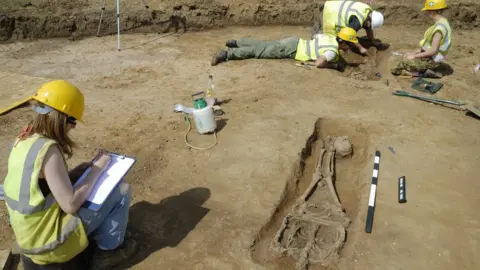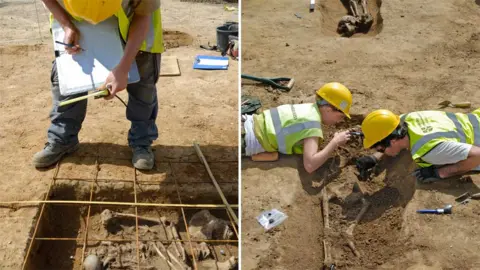Somersham headless bodies were victims of Roman executions
 Dave Webb, Cambridge Archaeological Unit
Dave Webb, Cambridge Archaeological UnitA cluster of decapitated bodies discovered at a burial site were probably from victims of Roman military executions, archaeologists have said.
The "exceptionally high" number of 3rd Century decapitated bodies were found at a military supply farm settlement at Somersham, Cambridgeshire.
Several were kneeling when they were struck from behind with a sword.
Archaeologist Isabel Lisboa said 33% of those found had been executed, compared to 6% in most Roman British cemeteries.
 Dave Webb, Cambridge Archaeological Unit
Dave Webb, Cambridge Archaeological UnitThree cemeteries were excavated revealing 52 burials, of which 17 were decapitated.
At least one of those executed - an older woman found face-down - appears to have been tortured immediately before death or mutilated afterwards.
Their heads were found placed at their feet or lower legs.
 Dave Webb, Cambridge Archaeological Unit
Dave Webb, Cambridge Archaeological UnitDr Lisboa, from Archaeologica, said they dated from a time of increasing instability for the Roman Empire, when legal punishments became harsher.
"The number of capital crimes doubled in the 3rd Century and quadrupled in the 4th Century," she said.
"As it was part of the Roman army, directly or indirectly, the severity of punishments and the enforcement of Roman law would have been more severe at the Somersham settlements," she said.
The settlement is believed to have supplied the Roman army, part of a wider network of nearby military farms at Camp Ground and Langdale Hale.
 Dave Webb, Cambridge Archaeological Unit
Dave Webb, Cambridge Archaeological UnitA "lack of genetic relationships" between the bodies suggests they were either in army service or slaves.
At least two of those found were born in Scotland or Ireland, and another in the Alps.
Dr Lisboa said "Knobb's Farm has an exceptionally high proportion of decapitated bodies - 33% of those found - compared with burial grounds locally and across Roman Britain."
Elsewhere, decapitated bodies make between 2.5% to 6% of burials.
Cambridge University's archaeology unit excavated Knobb's Farm between 2001 and 2010, ahead of gravel extraction by Tarmac Trading.
Analysis of finds has just been published.
 Cambridge Archaeological Unit
Cambridge Archaeological Unit
Find BBC News: East of England on Facebook, Instagram and Twitter. If you have a story suggestion email [email protected]
